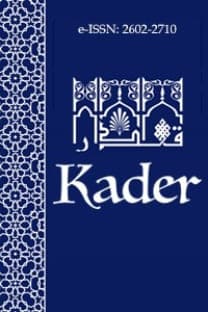Hz. Muhammed’in Nübüvvetine Delil Olan İnsanî Özellikler
Nübüvvet, ulûhiyyet ve ahiret ile birlikte İslâm inanç esasının üç ilkesinden biridir. Peygamberliğe dair hususlar bilhassa diğer din mensuplarıyla girişilen inançla ilgili tartışmaların ardından kelâmcıların en önemli konularından biri hâline gelmiştir. Bunun bir sonucu olarak bütün kelâm ekolleri insanın peygambere duyduğu ihtiyacı öne çıkarmış ve bununla nübüvveti temellendirmeye çalışmıştır. Bu çalışmada fizikî ve ahlâkî özelliklerinin Hz. Muhammed’in (sav) nübüvvetine delil oluşu ele alınmıştır. Kelâm’da nübüvvetin ispatında genellikle mucizelerden hareket edilmiştir. Ancak Hz. Peygamber’in nübüvvetini kanıtlarken fizyonomisi ve üstün ahlâkî nitelikleri de gündeme gelmiş ve bilhassa müteahhir dönem kelâmında yaygın olarak kullanılmıştır. Çalışma, giriş ve üç bölümden oluşmaktadır. Girişte çalışmanın konusu, amacı, yöntemi ve kaynakları açıklanmıştır. Birinci bölümde kelâm ekollerinin, mutasavvıfların ve Müslüman filozofların, Hz. Muhammed’in (sav) sahip olduğu fizikî ve ahlâkî özelliklerin nebevî delaletine dair düşüncelerine yer verilmiş ve nübüvvetin ispatında mucize dışında delil kabul eden bilginlerin görüşleri serdedilerek değerlendirilmeye tâbi tutulmuştur. Aynı zamanda Hz. Peygamber’in şemâili ve yaşantısının, onun nübüvvetine delil kabul edilip edilemeyeceği, kabul edilecekse hangi kriterlerin geçerli olduğu; mucizeyi destekleyici deliller olarak mı kabul edileceği yoksa tek başına nübüvveti ispatta yeterli mi görüleceği ve bu özelliklerin mucize sayılıp sayılamayacağı mevzuları açıklığa kavuşturulmaya çalışılmıştır. İkinci bölümde öncelikle Hz. Peygamber’in bir beşer olduğu gerçeği ortaya konulmuştur. Ardından Hz. Peygamber’in nübüvvetini kanıtlamada delil kabul edilen fizikî ve ahlâkî üstünlükler detaylıca açıklanarak, bu hususiyetlerin nübüvveti kanıtlamadaki işlevi değerlendirilmiştir. Sonrasında ise Hz. Peygamber’in nübüvvetine delil kabul edilen duyularına ait özellikler ile kokusu, teninin yumuşaklığı, boyunun uzun görünmesi, nübüvvet mührü, nûranî beyazlığı gibi bedenî özelliklerine dair hususlar ele alınarak bunların peygamberliği kanıtlamadaki geçerliliği izah edilmiştir. Çalışmanın son bölümünde ise Hz. Peygamber’in ahlâkî üstünlüklerine ve yaşantısına yer verilerek, bu özelliklerin onun nübüvvetini ispatlamadaki durumu açıklanmıştır. Hz. Peygamber’in doğru sözlü oluşu, güvenilirliği, zekiliği, her koşulda tebliğ görevine devam edişi, ismeti, merhameti, mütevazılığı, sabırlı oluşu, cesareti, hasbîliği, sade yaşantısı, yetkinleştirme gücü gibi özellikleri nübüvvetine delil olma bakımından ele alınmış ve değerlendirilmiştir. Ardından oryantalistlerin Hz. Peygamber’in ahlâkına yönelik iddiaları genel çerçevede değerlendirmeye tabi tutulmuştur. Sonuç olarak Hz. Peygamber’in bedenine ait bazı özelliklerini mucize kabul edip buradan hareketle peygamberliğini kanıtlama yönteminin isabetli olmadığını; ahlâkî özelliklerinin ise Kur’ân mucizesinin ardından onun nübüvvetini ispatlayan en güçlü ve kalıcı aklî deliller olduğunu söyleyebiliriz.
Anahtar Kelimeler:
Kelâm, Hz. Muhammed, Nübüvvetin ispatı, İnsanî özellikler, Fizyonomi, Şemâil, Ahlâk
Hz. Muhammed’in Nübüvvetine Delil Olan İnsanî Özellikler
Prophethood is one of the three Islamic belief principles, along with divinity (ulûhiyyet) and eschatology. Issues related to prophethood have become one of the most important themes of Mutakallim scholars, especially after belief discussions with members of other religions. As a result of this, all the schools of kalām emphasized the need of man for a prophet and tried to base prophethood on it/this idea. In this study, the physical and moral characteristics of Prophet Muhammad (pbuh) as proofs for his prophethood are discussed. Miracles are generally used in the proof of prophethood in kalām. However, to prove the Prophet Muhammad's prophethood, his physiognomy and superior moral qualities also discussed and were widely used, especially in the late period of kalām. The study consists of an introduction and three parts. In the introduction, the subject, purpose, method, and sources of the study are explained. In the first part, the thoughts of the schools of kalām, Sufis, and Islamic philosophers regarding the physical and moral characteristics of the Prophet Muhammad as evidence of his prophethood are included. In addition, the views of scholars who accepted other evidence besides miracles as the proof of prophethood are interpreted and evaluated. Moreover, whether the shamāil and life of the Prophet Muhammad can be accepted as evidence for his prophethood is discussed. If so, what kind of criteria is accepted, whether it is considered to be as the evidence supports the miracle or whether it is sufficient alone itself to prove prophethood, and finally, whether these features can be regarded as miracles have been tried to be clarified. In the second part, first of all, it is emphasized the fact that the Prophet Muhammad is a human being. Then, the Prophet Muhammad’s physical and moral superiorities accepted as evidence of the proof of prophethood are extensively explained, and the function of these features in proving the prophethood is evaluated. Later, the characteristics of prophet Muhammad’s senses, which are accepted as evidence for his prophethood, and his physical characteristics such as his odor, softness of his skin, his tall appearance, the seal of prophethood in his body, and his prophetic whiteness are discussed, then the validity of these features in proving the prophethood are evaluated. In the last part of the study, by mentioning the moral superiority and life of the Prophet Muhammad, the place of these features in proving his prophethood is explained. The qualities of the Prophet such as being truthful, reliable, intelligent, continuing his duty of preaching under all circumstances, his integrity, mercy, modesty, patience, courage, altruism, simple life, and his capacity to make up for the deficiencies are discussed and evaluated in terms of being evidence of his prophethood. Then, the orientalists' claims against the morality of the Prophet Muhammad are broadly evaluated. As a result, it can be said that the method of proving his prophethood by accepting some of the features of the Prophet Muhammad's body as a miracle is not correct; but his moral characteristics are the strongest and the most consistent rational evidence that proves his prophethood after the miracle of the Quran.
Keywords:
Kalām, Prophet Muhammad, Proof of prophethood, Humanitarian qualities, Physiognomy, Shamāil, Morality,
___
- Toprak, İbrahim. Hz. Muhammed'in nübüvvetine Delil Olan İnsanî Özellikler. Konya: Necmettin Erbakan Üniversitesi, Sosyal Bilimler Enstitüsü, Doktora Tezi, 2020.
- Başlangıç: 2003
- Yayıncı: Mehmet BULĞEN
Sayıdaki Diğer Makaleler
Abdülkâhir el-Bağdâdî’nin Kelâmî Düşüncesi
Determinizmin Yeni Savunması: Nörobiyolojik İndirgemecilik
İslam Düşünce Geleneğinde Tanrı Anlayışları I Eş’arîler
Kelâmda Mereoloji Arazlardan Hareketle Kurulan Hudûs Delilinin Yeni Bir Okuması
Kelâmın Fizik Kuramı: Basra Mu‘tezilesi Kozmolojisinde Atomlar, Uzay ve Boşluk
İbn Ebu’l-Hadîd’e Göre Ali b. Ebû Tâlib’in Siyasî Kararları
İnsan Ontolojisi Bakımından Necislik: Tevbe 9/28 Örneği
İslam Düşüncesinde İnsan Fiilleri: Farklı Söylemler Ortak Amaçlar
